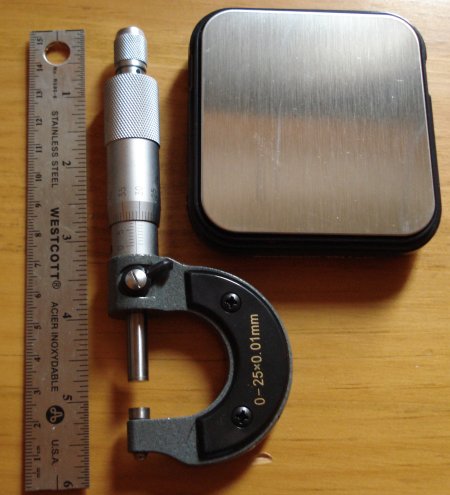
Okay, maybe the same amount of conversation. But in some cases, less subjective. I’ve acquired a few tools to assist in describing some of the physical properties of pencils – a ruler, micrometer, and scale. (Well, I already owned the ruler.)
Flat Cedar pencils
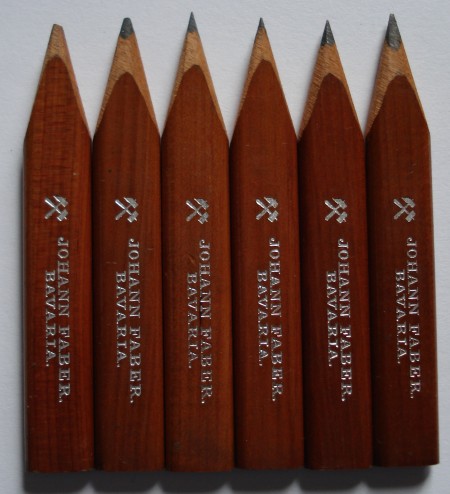
A special treat today – we are taking a look at “flat cedar” pencils. This is a historic pencil variety, no longer manufactured. They were made for waistcoat pockets, according to Henry Petroski’s The Pencil. And they are indeed very portable, even if you don’t have a waistcoat pocket.

I’ve had for some while an old Eberhard Faber pencil in this style. It is roughly in the shape of a miniature carpenter’s pencil, though with a round core. The pencil fits in a case with a cover that is removed and placed on the base to form an extender. I’m not sure of the material – tin or nickel would be my guesses – but it has survived well. “E. Faber, U.S.A.” is inscribed.

The pencil is already quite worn, and I was happy to find some refills – a partially filled box of “Johann Faber’s flat cedar refills with black leads. Made in Bavaria. No. 5837.”
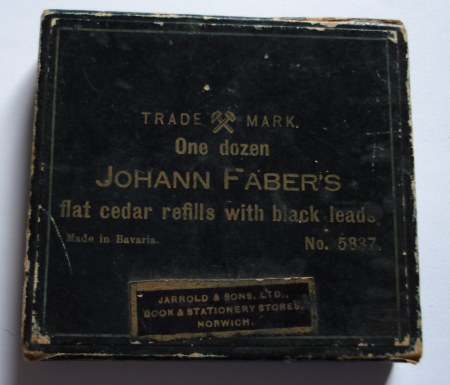
Unfortunately – they don’t fit! The various branches of the Faber family are known to have feuded, and it may be that these are different formats by design. (The J. Faber is narrower than the E. Faber.)
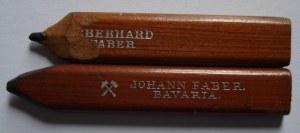
As pencils, the Johann Faber pencil lead is a lighter, harder lead than the Eberhard Faber version.
I’ll have to keep my eye out for flat cedar pencil supplies.

Firefox pencils
This is a great story about ordering promotional pencils. It’s full of photos and has step by step instructions on how to create and format the needed artwork. These particular pencils were commissioned for the Firefox web browser.
My only issue might be the pencil quality. Has anyone ordered novelty pencils with an emphasis on quality? I know that Mitsubishi, Kita-Boshi, and Tombow all make first rate novelty pencils, but I don’t think they take small orders from overseas!
The Blackfeet Indian Pencil revisited
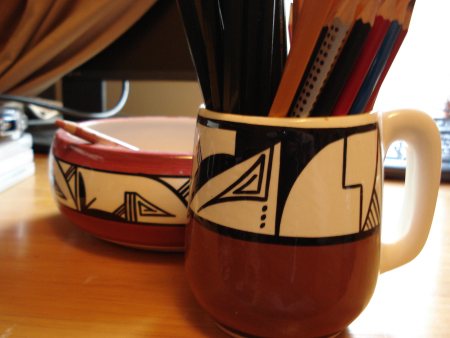
It’s almost two years ago that I wrote about the Blackfeet Indian Pencil. It remains one of the most popular posts at pencil talk.
While a lucky few were able to buy this pencil at retail, it never broke into mainstream distribution channels. The picture above shows some hand made ceramics that were sold along with the Blackfeet pencils in the early 1990s via specialty catalogs. Since a lot of people are interested in the culture around the pencil, this bit of context seemed relevant.
I recently gave the Blackfeet Nation offices a call to see if there is any news about their beloved product.
It’s not good. The Blackfeet Writing Instruments factory has been fully converted to another use, and all the pencil making equipment removed. With the machinery gone, a revival of the pencil isn’t even a remote possibility anymore.
The company was founded in 1972, and sold by the Blackfeet Nation to a private firm in 1992. In 1997, sales were a mere 27,000 pencils [1]. That’s probably a minuscule fraction of the number sold by the large firms. I’m not sure when they folded, but it seems to be around 2000.
They are sadly missed.
[1] Indian Country Today, March 20, 2000 An informative article.
Wheatley & Wilson Ltd. No. 200 pencil

It seems that the staff at a local art supply store have noticed that I like pencils. I learned that some old pencils had been found by the mother of one of the staffers, and it was thought that I would be an appropriate recipient. I was quite amazed.

The pencils are yellow, with a gold/white ferrule, and pink eraser.
They are stamped:
Made in Canada Wheatley & Wilson Ltd. Montreal, Quebec Custom Made Bonded Lead No. 200 F22/4
The type style is a classic mid-century industrial look, and is often emulated today.
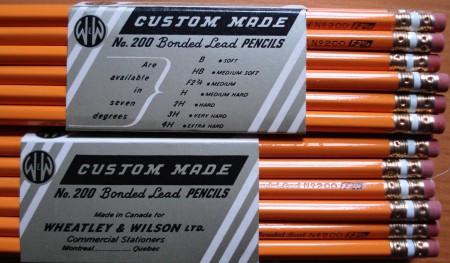
I can’t easily find any information about Wheatley & Wilson, although the McGill University Library reveals that Montreal does have a 1930 building with that company name, the Desbarats’ Building (The Gazette)/Wheatley & Wilson Ltd.
From the language on the packaging, it seems possible that Wheatley & Wilson had these pencils made for their stationery business. I’d love to know more about them. Is there anyone out there who recollects this name?

I sharpened one. It still has a nice “pencil” aroma. The lead is quite smooth for an F grade, and writes quite easily. A classic.
The General Pencil Company

General Pencil is not as well known as General Motors or General Electric, but they have an equally fascinating history.
Founded in 1889, the company has remained in the Weissenborn family for 118 years. Their 1900 factory on Fleet Street, Jersey City, remains, though the business is now headquartered in Redwood City, California, closer to the cedar industry. It is one of an extremely small number of pencil manufacturers to not have been acquired by a large conglomerate.
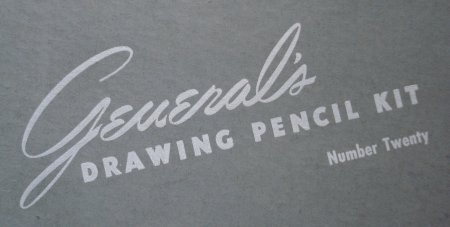
Today, the business press regularly hails them as a turnaround success, having made a tough and successful decision to focus on higher-end pencils, and dispense with trying to compete in the generic yellow No. 2 office pencil market.

Their website suggests they still do make office pencils, but you’ll have a hard time finding one. Where they shine are in art supply stores, and their largest retailer, the Michael’s craft chain. As well as graphite pencils, they are well know for charcoal, pastel, and chalk pencils.
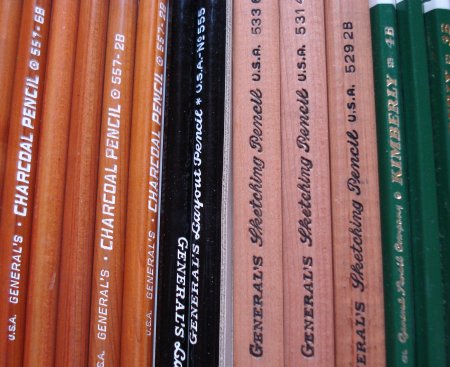
The Kimberley is the graphite pencil I’ve most often seen in Canada. It is green with a gold colored metal cap. The Semi-Hex, maybe a half-step down the quality ladder, is blue, with silver stamping and an unfinished cap. I’m not sure who first realized the potential the carpenter’s pencil had as an artist’s tool, but General sells them as “Flat Sketching Pencils” in another market niche. Their stongest area may be charcoal. Even the smallest rural school art supply store seems to stock General compressed charcoal sticks and charcoal pencils. The charcoal pencils are beauties, with classic dark stained finishes.
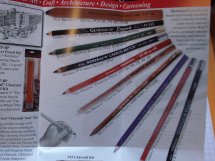 |
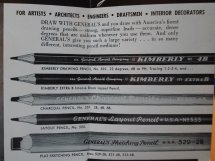 |
Brochures, new and old.
I think they have made the right decision to pursue these higher value areas. I would also encourage them to get online and do some selling and marketing.
It’s a delight to be able to present some interesting links:
New Jersey Public TV interview with the general manager of General Pencil
Urban Semiotic’s excellent 2006 photo and reminiscences about the General Pencil factory
National Public Radio 2005 story
New Jersey Business and Industry Association 2004 profile (PDF)
